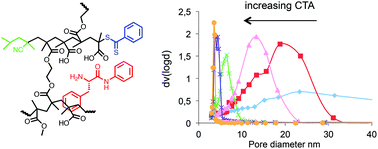Insights into the formation, structural properties and performance of RAFT polymerized l-phenylalanine anilide molecularly imprinted polymers†‡
Abstract
Conventional molecularly imprinted polymers (MIPs) are amorphous materials with a nonuniform microenvironment and a broad distribution of binding sites. Controlled radical polymerization has been demonstrated to improve their properties in this regard. The RAFT method was employed in the present study with the aim of achieving more homogeneous MIP monolithic structures. RAFT control by α-cyanobenzyldithiobenzoate was employed during the synthesis of a poly(methacrylic acid-co-ethylene glycol dimethacrylate) conventional MIP for L-phenylalanine anilide. The influence of the amount of the added RAFT agent on the polymerization as well as on the polymer porous structure and properties was studied. The results demonstrate that the RAFT agent promoted retardation and a more gel-like polymer morphology as reflected in a decrease in pore diameter and an increased swelling factor with the added RAFT agent. This was accompanied by an enhanced thermal stability of up to 100 °C compared to a corresponding MIP prepared by FRP. The RAFT polymers were then tested in the chromatographic mode due to their ability to resolve the racemate D,L-PheNHPh. An optimum RAFT agent level during polymerization was found to result in a markedly enhanced selectivity, column efficiency and resolution accompanied by a considerably higher sample loading capacity when compared to polymers prepared in the absence of the RAFT agent.

- This article is part of the themed collection: David Sherrington Commemorative Issue

 Please wait while we load your content...
Please wait while we load your content...